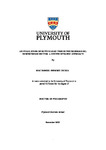AN EVALUATION OF SUPPLY LEAD TIME IN THE NIGERIAN OIL DOWNSTREAM SECTOR: A SYSTEM DYNAMIC APPROACH
| dc.contributor.supervisor | MOIZER, JONATHAN | |
| dc.contributor.author | UHUKA, MAC-DANIEL | |
| dc.contributor.other | Plymouth Business School | en_US |
| dc.date.accessioned | 2022-12-12T09:46:09Z | |
| dc.date.issued | 2022 | |
| dc.identifier | 10536690 | en_US |
| dc.identifier.uri | http://hdl.handle.net/10026.1/20061 | |
| dc.description.abstract |
MAC-DANIEL UHUKA. AN EVALUATION OF SUPPLY LEAD TIME IN THE NIGERIAN OIL DOWNSTREAM SECTOR: A SYSTEM DYNAMIC APPROACH. This thesis presents a system dynamics (SD) approach for investigating the demand amplification problem, also known as the bullwhip effect, which has been studied extensively in the literature. The demand amplification occurs when supply chain moves upstream from the downstream. The problem of bullwhip effect can be costly and disruptive, and this is a problem supply chain managers normally seeks to minimise. The causes of bullwhip effect can be poor system design, poor policies, structure of the company and delays in material and information flow. The bullwhip effect has since been linked to exogenous factors like uncertainty in demand, supply, and distribution lead time, but these causes are not solely to blame, as academic and operational studies have demonstrated that orders and/or inventories can still show significant variability even when customer demand and lead time are deterministic. Consequently, this raises the likelihood that the cause may exhibit dynamic behaviour and point to a need for more research into the issue. The Nigeria downstream petroleum industry is plagued with this problem of bullwhip effect such as long lead-times and customer order uncertainty. A system dynamics inventory model is built to identify the causes of these problems. The System dynamics (SD) inventory model of the downstream petroleum companies in Nigeria was developed in this research, to investigate uncertain customer order and the ability for the companies to manage their inventory to fulfil customer requirement at the same time reduce their overall total cost. The performance measure used for the simulation analysis is the total cost, oil distributor inventory, and retailer inventory storage. Three ordering patterns (base case, high order and low order) is used for the simulation to represent the scenario of these companies in Nigeria and to investigate the instability of the Nigeria downstream petroleum companies and the impact on the companies’ performance to ultimately reduce cost and increase profit for the companies. It was identified that the instabilities start from the downstream customers which makes the managers unable to effectively manage their inventory. The research findings provide more understanding how these instabilities occur and how it impacts supply chain companies using system dynamics modelling approach. | en_US |
| dc.language.iso | en | |
| dc.publisher | University of Plymouth | |
| dc.rights | Attribution-NonCommercial-NoDerivs 3.0 United States | * |
| dc.rights.uri | http://creativecommons.org/licenses/by-nc-nd/3.0/us/ | * |
| dc.subject | System dynamica modelling | en_US |
| dc.subject | Supply chain management | |
| dc.subject | Downstream oil supply chain | |
| dc.subject | Ordering policy | |
| dc.subject | Simulation | |
| dc.subject | Bullwhip | |
| dc.subject.classification | PhD | en_US |
| dc.title | AN EVALUATION OF SUPPLY LEAD TIME IN THE NIGERIAN OIL DOWNSTREAM SECTOR: A SYSTEM DYNAMIC APPROACH | en_US |
| dc.type | Thesis | |
| plymouth.version | publishable | en_US |
| dc.identifier.doi | http://dx.doi.org/10.24382/660 | |
| dc.identifier.doi | http://dx.doi.org/10.24382/660 | |
| dc.rights.embargodate | 2023-12-12T09:46:09Z | |
| dc.rights.embargoperiod | 12 months | en_US |
| dc.type.qualification | Doctorate | en_US |
| rioxxterms.version | NA |
Files in this item
This item appears in the following Collection(s)
-
01 Research Theses Main Collection
Research Theses Main



